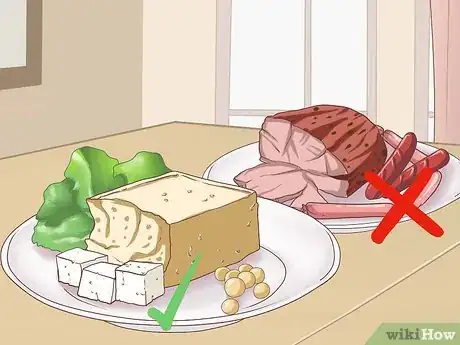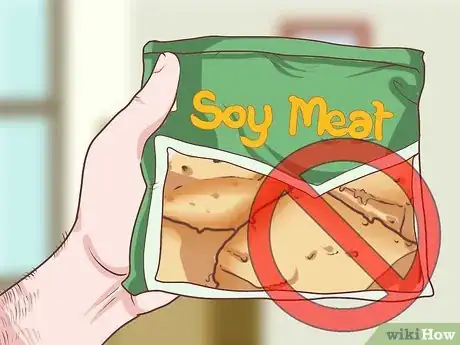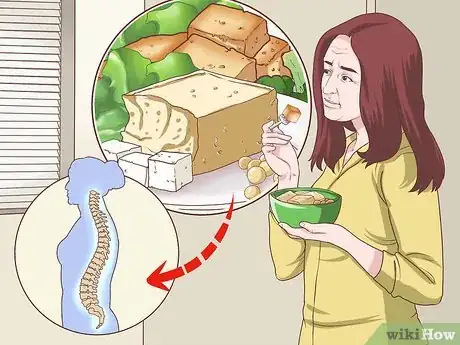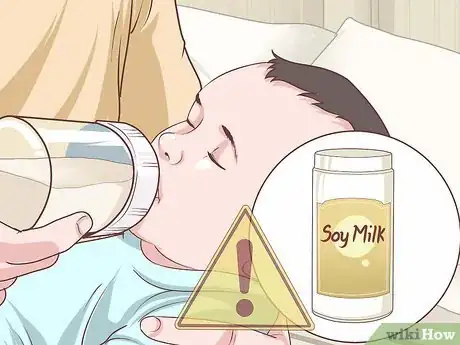This article was co-authored by Katie Rhodes-Smith RD, MS. Katie Rhodes-Smith is a Registered Dietitian and is the founder of OWN-Nutrition, LLC, a nutrition planning business for athletes based in Little Rock, Arkansas. Katie received her MS in Clinical Nutrition from the University of Arkansas for Medical Sciences. She is board certified Specialist in Sports Dietetics.
There are 13 references cited in this article, which can be found at the bottom of the page.
This article has been viewed 42,701 times.
The soybean is a plant in the pea family and is a source of complete protein, meaning it contains all the amino acids needed by humans to make more protein. Soy is controversial, though. Some people tout the benefits; others launch into lengthy discourse about its risks. If you want to eat soy it is probably best to learn how to eat it safely first.[1]
Steps
Learning How To Eat Soy Safely
-
1Know how to eat soy safely. The National Center for Complementary and Integrative Health (NCCIH), a division of the National Institutes for Health, considers soy safe for most people “when used as a food or when taken for short periods as a dietary supplement.” When choosing a soy product, it should be whole, organic, and non-GMO instead of refined or processed.[2]
- Research has indicated, however, that eating large amounts of soy can reduce fertility in women. It may also interfere with the normal development of fetuses and infants fed on soy formulas.
- Asian societies used soy for centuries without a problem. This is probably because in Asian cuisine, soy is usually used as fermented food like natto, miso, and tempeh. The process of fermentation may change some of the components of soy while leaving the isoflavones, which are the potential disease fighting elements in soy, unchanged and functioning in different ways.[3]
-
2Eat soy in moderation. Following the recommendations of NCCIH and the American Association of Family Physicians, men and women should eat soy in moderation. This means that adult men and women should limit soy to 25 grams a day. This means you can have one to two servings of soy product a day, like a cup of soy milk or four ounces of tofu.[4]
- A reasonable recommendations for those under 18 would be about half this amount, or 12 to 13 grams of soy each day.
- This amount of soy can benefit you by lowering cholesterol and triglyceride levels. The same amount of soy can decrease menopausal hot flashes and maintain bone density.
- Currently, there is not enough information to provide recommendations about how much soy for women with a history of breast cancer.
Advertisement -
3Replace unhealthy foods with whole soy. One of the benefits of whole soy is that usually soy products are eaten in place of unhealthier options containing more fat. Incorporating whole soy into your diet adds fiber, vitamins, minerals, and polyunsaturated fats.[5]
- Whole soy is a healthier option for protein over red meat. It includes high levels of protein without saturated fat.
- Whole soy can be used in place of red meat and dairy products, both of which can be unhealthy.
Incorporating Healthy Soy Into Your Diet
-
1Eat edamame. One of the best and healthiest ways to incorporate soy into your diet is to eat the whole soybean, commonly called edamame. A whole soybean has not been processed, so you are getting the nutrients from the bean.
- Try steaming the edamame. You can eat it as a side dish, or throw some into a salad.
- In half of a cup of soybeans, there is 16 grams of protein, along with a good amount of vitamin B6, vitamin B2, vitamin B1, Vitamin K, folate, potassium, magnesium, manganese, copper, selenium, phosphorus, iron, and calcium.[6]
- Buy organic or non-transgenic soybeans if possible.
-
2Drink organic soy milk. Another way to get healthy soy into your diet is to drink soy milk. To get the healthiest soy milk, make sure to buy organic and GMO-free. This eliminates the use of pesticides and potential dangers of GMO.
- One 8-ounce cup (237 ml) of soy milk daily is a good serving.
- For the best health benefits, get unsweetened and unflavored milk. Flavored milks have added sugars, which are not good for you.
- You can also make your own soymilk, which is even better than buying soy milk. All you need to make soy milk is organic non-GMO soybeans and purified (fluoride free) water.
- Check the labels of the soy milk before buying. Avoid buying any soy milk made with soy protein or soy isolate. This means the soy milk has been processed.[7]
-
3Cook with tofu. Tofu is a versatile, healthy way to incorporate soy into your diet. As with other forms of tofu, make sure to get organic soy that is non-GMO if possible. A daily serving of three to four ounces is acceptable.[8]
- Tofu can be used to replace meat in dishes. For example, you can make stir fries and other dishes with tofu instead of meat. Try tofu in place of eggs. You can also make tofu patties for tofu burgers. You can even try tofu chicken fingers.
- Try grilled tofu with vegetables as a side dish. Add tofu into your smoothie.
- There are many websites and books full of tofu recipes for you to try and enjoy.
-
4Eat fermented soy dishes. Many believe that fermented soy dishes are the healthiest way to eat soy. Many Asian dishes are fermented, such as tempeh, miso, and natto. Fermented soy products are easier to digest, and they are good sources of probiotics.[9]
- Tempeh is high in protein and B-vitamins, along with other minerals. Tempeh is versatile and can be put into many dishes, such as salads and even tacos.
- Miso has a lot of B12. Miso is generally found in a paste and soup, which can be purchased in stores.
- Natto is a paste made from fermented soybeans. It is most commonly found in health food stores, online retailers, or Asian grocery stores.
-
5Avoid processed soy products. While eating whole, organic, non-GMO, and fermented soy products provide healthy forms of soy, all other forms of soy should be avoided. This includes soybean oil, soy proteins, soy burgers, soy energy bars, and other forms of refined or processed soy.[10]
- Avoid anything with the words soy protein or soy isolate on the label.
- Refrain from eating products made with soybean oil.
Understanding Soy
-
1Learn the importance of phytoestrogens. Soybeans and soy products contain isoflavones, a class of plant substances that includes phytoestrogens. Phytoestrogens are substances that are similar in structure to human estrogens.[11]
- In some circumstances, they can either increase or decrease the effects of human estrogens. Because of this, eating soy has raised some concerns about reproductive cycles, fertility, puberty, and overall safety.
- The main phytoestrogens in soy are genistein and daidzein. These phytoestrogens have been labeled endocrine disruptors; however, the disruption can be positive or negative depending on a number of variables, including age, gender, and hormonal status.
- The isoflavones in soy can also act as goitrogens, substances that interfere with normal thyroid function.[12]
-
2Know how eating soy can benefit your health. Soy has been recommended to help with various health conditions. Soy has been used to help with menopausal symptoms, such as hot flashes, to help reduce the risk of osteoporosis, and to aid in lowering the risk of heart disease, especially in women).Soy has also been used for lowering LDL cholesterol and prostate cancer.[13]
- The results for the benefits of soy have not always been consistent, however.
- This inconsistency can be due to a number of issues, including how much soy is ingested, in what form, and the individual variations of people to soy based on their particular hormonal status at the time.
-
3Understand the risks of soy. The benefits or dangers of soy is inconclusive. For example, phytoestrogens have been implicated in increasing the risks of breast cancer in lab animal studies. Human breast cells are also affected by the phytoestrogens; however, many studies have also indicated that women who eat soy regularly have a lower risk of breast cancer.[14]
- In men, some studies have indicated that soy can lower sperm count. Other studies have indicated no effect at all.[15]
- Most of the studies have been conducted in lab rats and mice, but the concerns exist because rats and mice have hormonal systems that are similar to those in humans.
-
4Understand the risks of soy for children. While the studies done on lab animals or adult humans are a mix of benefits and risks, the studies of soy in children are less promising and the evidence of harm is more significant.
- In one study, infant girls who were fed soy-based formula had significantly more breast tissue at the age of 2 years than girls who were breast-fed or fed a dairy-based formula.[16] The use of soy-based infant formula is also associated with early puberty for girls as well as longer and more difficult menstrual cycles.[17]
- Infant formula based on soy should be avoided completely, unless specifically recommended by your child's pediatrician.
References
- ↑ http://www.aafp.org/afp/2009/0101/p43.html
- ↑ https://nccih.nih.gov/health/soy/ataglance.htm
- ↑ https://www.hsph.harvard.edu/nutritionsource/soy/
- ↑ http://www.aafp.org/afp/2009/0101/p43.html
- ↑ https://health.clevelandclinic.org/are-meat-substitutes-healthy/
- ↑ https://www.urmc.rochester.edu/encyclopedia/content.aspx?contenttypeid=76&contentid=16111-1
- ↑ https://health.clevelandclinic.org/are-meat-substitutes-healthy/
- ↑ https://www.bbcgoodfood.com/howto/guide/ingredient-focus-tofu
- ↑ https://www.bmj.com/company/newsroom/fermented-soy-products-linked-to-lower-risk-of-death/
- ↑ https://www.betterhealth.vic.gov.au/health/healthyliving/soybeans
- ↑ https://www.hsph.harvard.edu/nutritionsource/soy/
- ↑ http://www.ncbi.nlm.nih.gov/pmc/articles/PMC1241182/
- ↑ https://www.betterhealth.vic.gov.au/health/healthyliving/soybeans
- ↑ http://jnci.oxfordjournals.org/content/95/12/906.short
- ↑ https://www.uchicagomedicine.org/forefront/health-and-wellness-articles/dont-make-the-mistake-of-letting-a-diet-kill-sperm
- ↑ http://www.ncbi.nlm.nih.gov/pubmed/18223379
- ↑ http://jama.jamanetwork.com/article.aspx?articleid=194106

































































Medical Disclaimer
The content of this article is not intended to be a substitute for professional medical advice, examination, diagnosis, or treatment. You should always contact your doctor or other qualified healthcare professional before starting, changing, or stopping any kind of health treatment.
Read More...